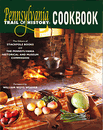Feeding Revolutionary War Soldiers
This article originally appeared in Pennsylvania Trail of History Cookbook
People who visit battlefields and historic encampment sites take for granted the enjoyment of a picnic or dining at a nearby restaurant, but Revolutionary War soldiers had no such luxuries. The Continental Congress on June 16, 1775, authorized appointment of a quartermaster general and a commissary general of stores and provisions for the Continental Army.
Officially, soldiers were to be issued daily rations that were to include meat (often beef or pork), bread (often hardtack), dry beans or peas, and a gill of rum or beer. Salted and dried foods were necessary because there were no other practical means of food preservation. Often soldiers boiled their dried beans or peas with the meat to make a makeshift stew. Many soldiers resorted to soaking their hardtack * in warm water or stew to soften it. Milk, turnips, potatoes, onions, and fish might also appear on the menu.
While it was the intent of the Continental Congress to provide ample rations for soldiers, good intentions were not enough to keep the army fed. Soldiers were lucky to receive even half their rations, and this did not provide them with a balanced diet. Vegetables were often in short supply. Vinegar was later added to the rations to prevent scurvy, but it often was not available. Transportation of supplies was the most serious problem, not only for the Continental Army, but more significantly for the British Army. Soldiers often relied on local purchases, food donations, and food sent by their families. They also hunted game and gathered wild foods and herbs along the way.
General George Washington authorized local farmers to sell their products at camp markets, but most soldiers had little money to buy food. Justifying their actions by necessity of war, soldiers learned to "liberate" provisions. One sergeant recorded that when his patrol happened upon a sheep and two large turkeys "not being able to give the Countersign," they were "tryd by fire and executed by the whole Division of the free Booters."
* Recipes are available in the Pennsylvania Trail of History Cookbook
Visit
Brandywine Battlefield Park, Chadds Ford, PA
Follow in the footsteps of George Washington at this revolutionary battlefield.
Washington Crossing Historic Park, Washington Crossing, PA
See where Washington's army crossed the Delaware River on Christmas Night, 1776.
For Further Reading
 |
Pennsylvania Trail of History Cookbook Edited by Kyle R. Weaver, Diane B. Reed, and Fred Lauver Forward by William Woys Weaver Stackpole Books and Pennsylvania Historical and Museum Commission 2004 |
 |
Washington Crossing Historic Park: Pennsylvania Trail of History Guide by John Bradley Stackpole Books and Pennsylvania Historical and Museum Commission 2004 |


